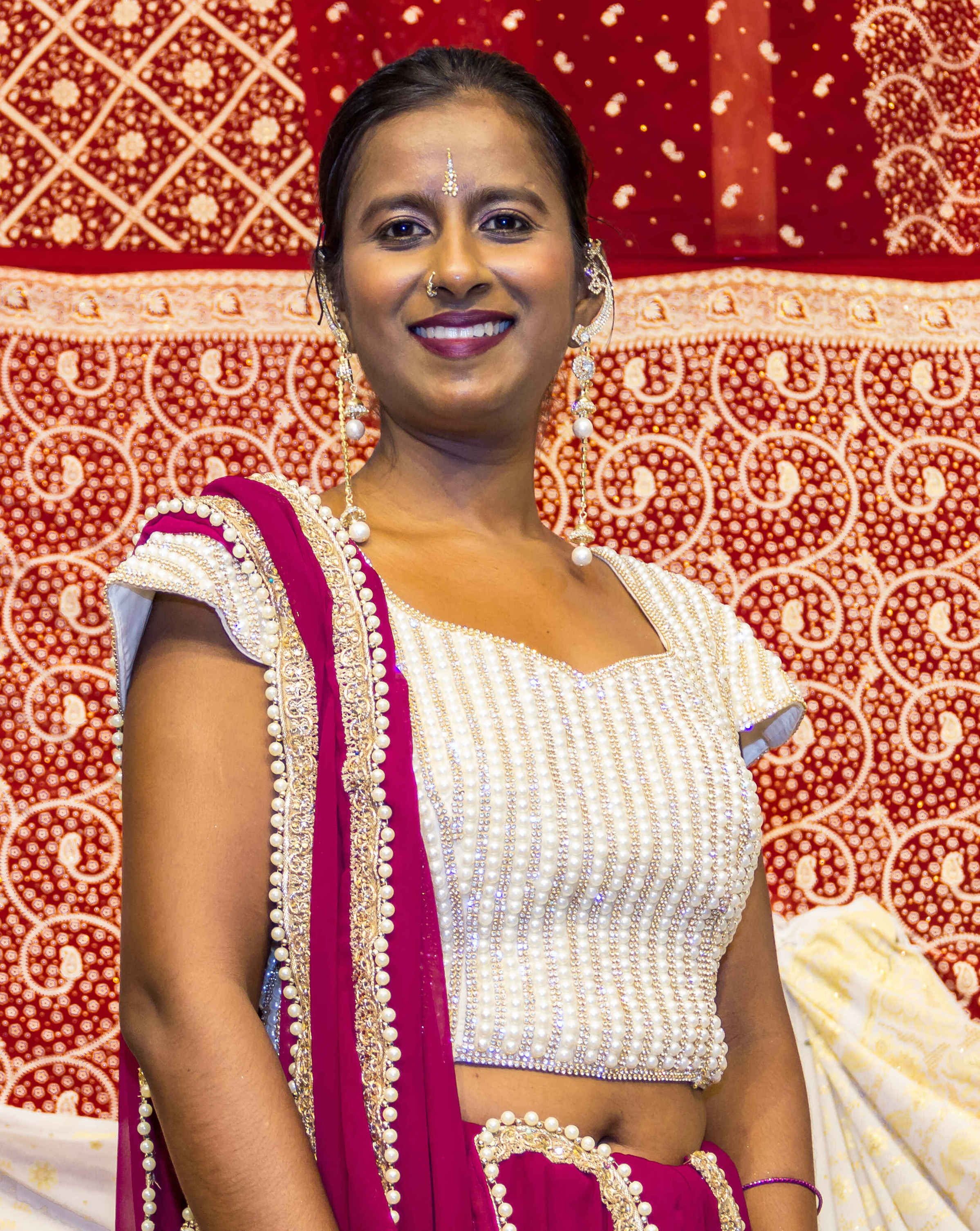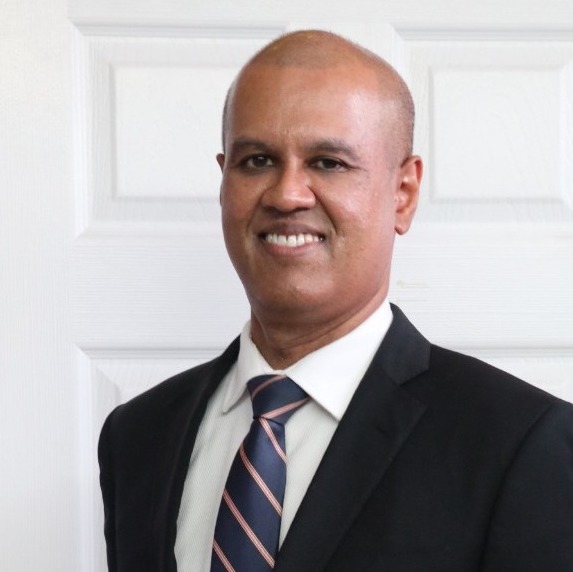 |
|
Kamala Budri. Photograph by Suraj Gopaul.
“Happy, healthy, hilarious being!” That is the answer that Kamala Budri enthusiastically gives me when I ask her the question, “Who is Kamala Budri?”
Whilst her response is somewhat appropriate, I realise after my interview with her for this story that it is rather modest. She does indeed seem to be happy, healthy and hilarious, but that is just the tip of the iceberg for a young lady whose diverse accomplishments cover the spectrum of academia, singing, dancing, broadcasting, writing and emceeing.
“ ‘Nadan Parindey’. It translates to ‘innocent bird’. It’s a term used by my Indian friend Zubair Kongwani, and it aptly describes my journey into academic life, singing, broadcasting and the general navigation of life,” she continues.

Pioneer Dragon Fruit Farm, Rochard Road, Penal 2022. Photograph by Suraj Gopaul.
Readers of Paradise Pulse print and online magazines will recognise Kamala as someone who has written feature articles in the past. Music aficionados, especially those with an affinity to East Indian rhythms, will know her voice from the 103.1 FM radio frequency, and more recently Radio 90.5 FM.
Born in San Fernando in the 1980s to devout Hindu parents, Chabilal Budri and Geeta Singh, Kamala shares some insights on her upbringing and her entry into the cultural landscape. “Cultural influences came from initial parenting, then temple and other tertiary agents of socialization. My nana (maternal grandfather) was rooted in dance, and he laid a foundation which I juxtaposed with Shastriya Sangeet (Hindustani classical music), Hindi Geet (filmi songs) and Hindi Bhaasha (Hindi language). I am the first in at least four generations to be a singer.”
But how did her initial love for dancing lead to singing? It’s an amusing story that Kamala eagerly shares. “At primary school age, I began Kathak dancing with my aunt, Indira Rameshwarsingh, who was tutored by Shri Pratap Pawar. In my mind I was slaying it! The best classical eight (8) year old dancer ever! My aunt lovingly supports me to date but when my family saw my performances, they remarked, and I quote, ‘Huh! The song now start and Kamala finish dance.’ Such was the harsh reality of my tender life but the truth took me to discover a magnificent strength, embryonic and soon ready to change my little dancing world.”

Kamala dancing on the Mastana Bahar preliminary round in 1996 at Gulf City Mall, La Romaine.
Still, she was adamant about becoming a dancer. It was, after all, in her bloodline. “My nana was a Harichan dancer and his daughters performed Indian classical dance as a group known as Singh’s Trio. My mother also performed solo as a Thaali (round metal plate) dancer.” This led Kamala to pursue the more popular Indian Film dancing and that landed her a couple of performances on the local East Indian talent show, Mastana Bahar. Although she danced with a group, it was meaningful for her because her mother had graced the final of the competition in 1970, its premiere year.
But while she enjoyed dancing, there was a void since she wanted to accomplish more culturally. Following in her mother’s footsteps, she began Hindi and Shastriya Sangeet classes at Bharitya Vidya Sansthaan (B.V.S). This was a turning point in her life as she developed a deep appreciation for the syllabus which, as she puts it, had been intelligently crafted by Professor Hari Shanker Adesh. “A switch flipped on in me,” Kamala muses.
Whilst at B.V.S. her close friend, Anand Dwarika, encouraged her to sing a Hindi film song for the first time in one of their plays in which he played the accompanying music to Lata Mangeshkar’s Hogaya Hain Tujhko from the blockbuster 1995 film Dilwale Dulhaniya Le Jayenge. Anand unfortunately passed away in 2008, a loss which continues to hurt Kamala. “He was an integral part of my early teenage life. He guided me as an elder brother and would even bring an extra bicycle on temple days so that later we could all ride in a group because I was not allowed to ride far by myself.”

Kamala's first performance singing on Children of Mastana in 1997 at Rienzi Complex, Couva.
But Anand’s influence lived on. It pushed her to sing on a national forum. Enter Children of Mastana, a spinoff of Mastana Bahar, focusing on talented young performers. Kamala’s first foray was at the age of fourteen and it also marked her television debut. She did not progress beyond the first round but returned the following year in 1998 and made it to the finals where she performed the patriotic Lata Mangeshkar classic Aye Mere Waton Ke Logon to secure seventh place. The nation began to take notice.
Though dancing had now been relegated to second place in her list of passions, she did not abandon it but instead continued to work on her coordination skills. She joined the Latin and Ballroom Club at Iere High School where she also performed Thaali dancing, as taught to her by her mother, for cultural programmes. Indeed, she viewed dancing as a way to complement her singing. “I never liked the idea of standing on a designated spot and simply singing. My idea of performance is an entertaining presentation whereby the audience can truly grasp and appreciate what is being delivered. I guess in a way it was how I kept dance with me.”
But her singing continued to take centre stage, both literally and figuratively. In 2001 she auditioned for Mastana Bahar with the immortal classic Rahe Na Rahe Hum from the 1966 movie Mamta, and graduated to the semi-final with the 1967 melody, Saamne Mere Sanwariya. The year after, she rendered Jaoon Kaha Bata Aye Dil (from 1959's Chhoti Behen) and also delivered Oh Aasman Waale out of the 1953 album Anarkali. 2003 was, however, her best singing year as she delivered her finest performances of Sayonara (from the 1966 film Love in Tokyo) at another preliminary and Buddha Mil Gaya (from 1964’s Sangam) at the semi-finals. These songs had rarely if ever been previously performed on the programme. For many of these vocal performances she won the coveted People’s Choice Prize, thereby confirming that in the eyes of the audience she was somewhat of a trail blazer. This motivated her to enter other national contests, such as the National Ladies Singing Competition and Caribbean Tarang, where she expanded her learning alongside cultural stalwarts.

Nani, Ramdoolarie Rameshwarsingh, enjoying the hattrick victory stage side, 2003 for NCIC's & Coca-Cola’s Teen Talent Contest at NCIC Nagar.
In 1999 Kamala entered the National Council of Indian Culture (NCIC Nagar) Coca-Cola Teen Talent Contest. She was unplaced, but much like her initial experience in Children of Mastana, she remained undeterred. In 2001 she re-entered, performing Kanha Aan Padi Main Tere Dwar from the movie Shagird. She won, becoming the first female singer to cop the title. But that was only the beginning. With the support of her family, she again entered in 2002 and 2003, winning on both occasions and in the process becoming the first and only female hattrick winner of the competition.
She later began volunteering some of her time to assist the NCIC with its numerous cultural endeavours, a practice that she joyously continues to date.

Pioneer Dragon Fruit Farm, Rochard Road, Penal 2022. Photograph by Suraj Gopaul.
In 2009, at the NCIC’s Indian Arrival Day celebration, Kamala experienced a life-changing moment. The organisation’s President, Dr. Deokinanan Sharma, approached her, saying that he wanted to speak with her. Her heart sank and she began wondering what she had done wrong. A multitude of negative thoughts flooded her mind about what the President of the NCIC would possibly have to tell her. As it turned out, her fears were unwarranted. He removed a piece of paper from his kurta pocket, handed it to Kamala and told her, “I think you should apply for this.” The document was an advertisement for a cultural exchange/tourist visit programme to India called Know India Programme which he felt that she would be interested in. Kamala eagerly signed up and was one of five nationals of Trinidad and Tobago who were selected by the Indian government for the trip. Later that year she made her maiden visit to her ancestral home. It was the fulfilment of a lifelong yearning.
Following Kamala’s triumphs, new doors began to open. She has two sisters, who she treasures dearly, and in 2011 a friend of one of them sent Kamala’s resume to Radio 103FM for a competition. When station personnel heard her voicing scripts which she had researched, they offered her a spot on air. She became a radio presenter, eventually developing a loyal fanbase. “I still say that radio chose me and not the other way around. It amazes me up to today when I get to see the difference I make through comments, calls and requests of my listenership.”

First on air presentation with 103FM, 2011, St. James.
The following year, another exciting opportunity emerged. The government of India was inviting interested persons to apply for scholarships to pursue post-graduate degrees. And apply Kamala did, and successfully so. She had always dreamt of one day returning to visit India, but never in her wildest expectations did she ever think that she would get an opportunity to live and study there.
In 2012 Kamala left for India where, over the next year, she pursued a Master’s Degree in Human Resource Planning and Development on scholarship from the Indian government. Her experience there birthed new curiosities and deepened her love for yoga, adventure, spirituality, anthropology, culture and, of course, academia. She excelled, securing first division grades, and later chronicled her experiences in her popular, ‘A Trini Girl visits India’ trilogy of articles for Paradise Pulse print magazine.

Streets of Jaipur, India charming a cobra, 2012.

Ganges, Haridwar, India 2012. Photograph by Kamal Baboeram.

In front of the Taj Mahal, Agra, India with classmates, 2012.
Her most memorable experience was travelling to Birapur, Allahabad to meet her maternal ancestors for the first time, a journey which she shared with Paradise Pulse readers in its 2020 issue.

Kamala feeding her ancestor, Raj Kishore, in his home at Baraut, Allahabad, India 2012.
Her departure to India meant that she had to temporarily give up her passion of radio broadcasting. In 2013, upon her return to Trinidad, she resumed radio duties at 103 FM where she remained until 2017. In 2019 she started at Radio 90.5 FM on which she at present hosts the programmes Saturday Mehfil(from 2:00 p.m. to 6:00 p.m.) and Sunday Roja (from 10:00 a.m. to 2:00 p.m.) TT time.
But her talents were also being recognised beyond the scope of singing, dancing and radio broadcasting. Starting in 2011, her voice talent morphed, leading her to become a Mistress of Ceremonies (MC) for cultural events and private functions, working primarily with the High Commission of India to Trinidad and Tobago (HCITT), Mahatma Gandhi Institute for Cultural Cooperation (MGICC), NCIC Nagar and Pioneer Scout Group (based at Rochard Road, Penal). In 2015, she made her writing debut for Paradise Pulse online magazine with a movie review of the Bollywood hit Happy New Year.

Kamala hosting Divali celebrations at Gulf City Mall, La Romaine for Pioneer Scout Group in 2017. Photograph by Suraj Gopaul.
So, after all of this, does Kamala have any regrets? “I surely burned to learn too many times, but how can I improve if there was no failure?”
She expresses her gratitude to her family and the cultural visionaries whose tireless efforts inspired her to propagate East Indian culture in Trinidad and Tobago.
Kamala is saddened that her nana is not around to share in the joy of her achievements. “I believe my nana deserves to be here beside me because this is his victory and I continue as his legacy.”
But she presses on, mindful of what she now considers a spiritual obligation to be one of the torchbearers of Indian culture in the Caribbean in the 21st century. “As the Dutch historian Johan Huizinga said, ‘If we are to preserve culture we must continue to create it.’ ”
Kamala ends with the signature introduction and sign-off sentence that listeners to her popular radio programmes have become accustomed to: “I remain your humble host aur dost, Kamala Budri.”
Kamala remains available for performances and emceeing duties and she can be contacted via email at kamalabudri@gmail.com as well as via instagram and facebook @kamalabudri .
All photographs in this article are courtesy of Kamala Budri.
 |
By: Chris Selochan | MUSIC-CULTURE | May 2022 |
Tweet |
Warning: array_search() expects parameter 2 to be array, null given in /home/paradisepulsea/public_html/pages/article.php on line 87
Warning: in_array() expects parameter 2 to be array, null given in /home/paradisepulsea/public_html/pages/article.php on line 104
Warning: array_search() expects parameter 2 to be array, null given in /home/paradisepulsea/public_html/pages/article.php on line 87
Warning: in_array() expects parameter 2 to be array, null given in /home/paradisepulsea/public_html/pages/article.php on line 104
Warning: array_search() expects parameter 2 to be array, null given in /home/paradisepulsea/public_html/pages/article.php on line 87
Warning: in_array() expects parameter 2 to be array, null given in /home/paradisepulsea/public_html/pages/article.php on line 104


| Subscribe |










%20-%20Copy.jpg)

